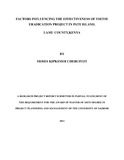| dc.description.abstract | Tsetse eradication project was initiated in Pate Island in the year 2009 with the objective of
eradicating tsetse l1y and trypanosomiasis in the Island using combinations of approaches and
techniques developed lor use outside Kenya Coast. The study is about analysis of the factors
influencing the effectiveness of tsetse eradication in Pate Island. It was undertaken to appraise
the effectiveness of the project in meeting the objectives three years into the operation. Literature
review revealed that community engagement. installation of insecticides targets. spraying of
animals, training of farmers and treatment of animals that come down with trypanosomiasis arc
factors that influence tsetse eradication. The descriptive survey research was employed in the
stud) because it enabled the researcher to generalize its findings to larger population or Pate
Island. Tsetse flies were sampled using 20 geo-referenced biconical traps (Challie'r et al, 1977)
baited with phenols and acetone where flies were collected for 72 hours at 24 hour intervals.
There were no flies caught (n= 20). Trypanosome parasite were surveyed by screening blood
samples lor trypanosomes using Standard Trypanosome Detection Methods (STDM), namely
wet, thick. and thin smear examination as well as llaematoerit Centrifugation Technique. Buffy
Coat examination. No parasite was detected (n=-408). Semi structured questionnaires (n 60)
were used to collect data on community engagement, training of farmers and spraying of
animals. Data was analyzed using SPSS software and presentation was descriptive and
qualitative techniques. Statistical analysis frequency distribution was used. The study established
factors that influenced the effectiveness of tsetse eradication were: cornmunuy engagement.
target installation, animal spraying. and training of farmers and treatment or infected animals.
The study concluded that the five factors indeed had influence on the effectiveness olthc Project.
Recommendations made were: community members be involved in project activities,
conventional insecticide impregnated target is effective against Glossina austeni tsetse 11y
species. alternative insecticide formulation that would not require use of spray pump would be a
better option for Pate farmers, there should be continuous training of farmers on vector and
disease control and due diligence be instituted in the use of trypanocides in order to avoid drug
resistance.
Key words: l:fTeCfivC!ness, eradication, tsetse, /1),pClI10Somi(f.'·IS | en_US |

